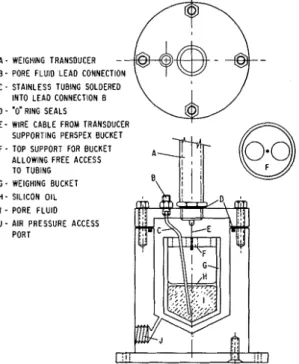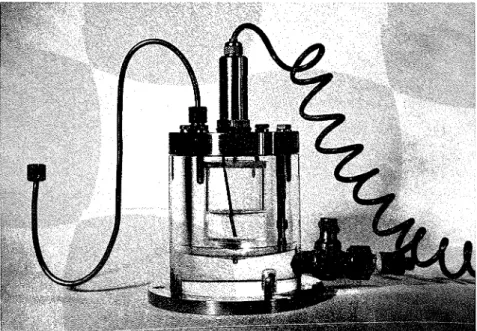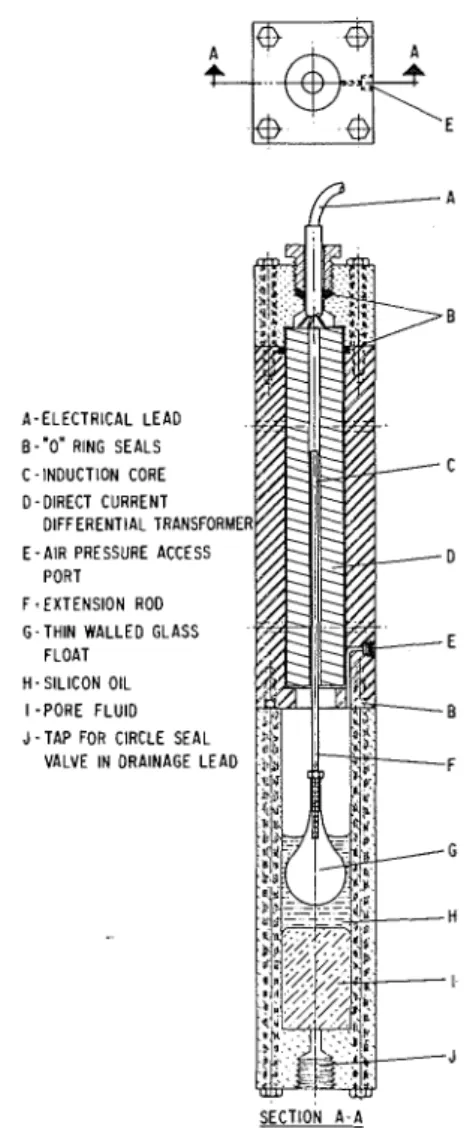Publisher’s version / Version de l'éditeur:
Canadian Geotechnical Journal, 8, 2, pp. 341-345, 1971-05
READ THESE TERMS AND CONDITIONS CAREFULLY BEFORE USING THIS WEBSITE.
https://nrc-publications.canada.ca/eng/copyright
Vous avez des questions? Nous pouvons vous aider. Pour communiquer directement avec un auteur, consultez la
première page de la revue dans laquelle son article a été publié afin de trouver ses coordonnées. Si vous n’arrivez pas à les repérer, communiquez avec nous à PublicationsArchive-ArchivesPublications@nrc-cnrc.gc.ca.
Questions? Contact the NRC Publications Archive team at
PublicationsArchive-ArchivesPublications@nrc-cnrc.gc.ca. If you wish to email the authors directly, please see the first page of the publication for their contact information.
NRC Publications Archive
Archives des publications du CNRC
This publication could be one of several versions: author’s original, accepted manuscript or the publisher’s version. / La version de cette publication peut être l’une des suivantes : la version prépublication de l’auteur, la version acceptée du manuscrit ou la version de l’éditeur.
Access and use of this website and the material on it are subject to the Terms and Conditions set forth at
Electronic measurement of changes in the volume of pore water during
testing of soil samples
Mitchell, R. J.; Burn, K. N.
https://publications-cnrc.canada.ca/fra/droits
L’accès à ce site Web et l’utilisation de son contenu sont assujettis aux conditions présentées dans le site LISEZ CES CONDITIONS ATTENTIVEMENT AVANT D’UTILISER CE SITE WEB.
NRC Publications Record / Notice d'Archives des publications de CNRC:
https://nrc-publications.canada.ca/eng/view/object/?id=33a21c61-b60d-4460-a26a-038029ebe5e1 https://publications-cnrc.canada.ca/fra/voir/objet/?id=33a21c61-b60d-4460-a26a-038029ebe5e1TECHNICAL NOTES 341
Electronic Measurement of Changes in the Volume of Pore Water During Testing
of Soil Samples
R.
J. MITCHELLDepartment of Civil Engineering, Queen's University, Kingston, Ontario
AND
K. N. BURN
Geotechnical Section, Division of Building Research, National Research Council of Canada, Ottawa, Canada
Received December 21, 1970
Two systems are described for electronic recording of changes in the volume of pore water for triaxial testing of soils: one using a miniature force transducer to measure by direct weighing; the other based upon a float system connected to the core of a differential trans- former. Both systems provide measurement of volume change at least as accurately as may be obtained by visual reading of burettes graduated to 0.1 em3, i.e. to 20.05 cm3.
L'article dtcrit deux methodes pour enregistrer Clectroniquement les changements volumiques de I'eau interstitielle pour les essais triaxiaux des sols: la premitre utilise un transducteur B faible tension pour mesurer par la pesCe directe; I'autre est basCe sur un systtme de flottaison rac- cord6 au noyau d'un transformateur diffkrentiel. Les deux mCthodes fournissent les mesures du changement volumique aussi exactement qu'on peut les obtenir B I'aide de burettes graduks i 0.1 cmS, c'est-bdire k0.05 cm3.
T o complete automatic recording of all per- tinent parameters during triaxial testing, two instruments were developed for electronic mea- surement of water-content changes in soil sam- ples. These instruments were designed for use in systems where air pressure is used to "back pressure" the pore fluid.
The first instrument operates on the direct- weighing principle and appeared, initially, to be the more accurate method of measuring volume change. Problems became apparent, however, during calibration, and a second instrument operating on a float-displacement principle was developed. Both instruments are described in this note.
Direct-weighing Instrument
Details of the design and a photograph of the &st instrument are presented (Figs. 1 and 2).
The weighing container is physically indepen- dent of all leads and accuracy is limited only by the performance of the weighing transducer. A layer of silicon oil is floated on the surface of the pore fluid to reduce the long-term effect of evaporation.
The weighing transducer used with this in- strument operates on a system of flexible metal proving discs attached to floating strain gauge wires. Applied air pressures equalize throughout
A - WEIGHING TRANSDUCER -
0 - PORE FLUID LEAD CONNECTION C - STAINLESS TUBING SOLDERED
INTO L E A 0 CONNECTION B D - '0" RING SEALS
E - WIRE CABLE FROM TRANSDUCER SUPPORTING PERSPEX BUCKET F - TOP SUPPORT FOR BUCKET
ALLOWING FREE ACCESS TO TUBING G - WEIGHING BUCKET H - SILICON O I L I - PORE FLUID J - AIR PRESSURE ACCESS
PORT
FIG. 1. Direct-weighing instrument (design), full
scale.
the instrument and interior of the transducer. Measurement accuracy was found to be 20.5 cm3 (as predicted by the transducer characteris- tics) under no back pressure. The application Canadian Geotechnical Journal, 8 , 341 (1971)
TABLE 1. Performance of instruments
Calibration
Capacity Power Transducer
Instrument cm3 supply Output accuracy Constant Stability Accuracy Remarks
Direct- 7V, 60mV, + 0 . 1 5 % 1.95 Average 0.01 cm3/day
+
0.05 Reduced accuracy underweighing 30 d.c. d.c. full scale mV/cm3 under pressure cm3 pressure due to drift
correction
Float- 7V, +6V, + 0 . 5 % 0.609 Negligible
+
0.02 Operation independent ofTECHNICAL NOTES
FIG. 2. Direct-weighing instrument.
344 CANADIAN GEOTECHNICAL JOURNAL. VOL. 8, 1971 of pressure caused a small change in the trans-
ducer reading and resulted in a nearly linear drift of the transducer readings under constant load. Complete enclosure of the transducer in the pressure chamber failed to eliminate drift. Sealing the transducer from the pressure by means of a latex membrane eliminated the drift, but it seriously reduced the sensitivity of the transducer.
A major modification using flexible pressure and pore water leads was tried; the leads were sealed into the weighing container and the com- plete system was weighed. Although this elim- inated transducer drift, it was found that pres- sure changes affected the flexibility of the leads and the readings changed if an external agency caused minor fluctuations in the alignment of the system.
Calibration information for this instrument is presented in Table 1. The prototype is used for volume measurement in tests that do not require a back pressure.
Float-displacement Instrument
A photograph and details of the design of the second instrument are shown in Figs. 3 and
4. The measuring system is composed of a d.c.d.t. (direct current differential trans- former) transducer with a core supported on a glass float. Glass floats were blown from 3-mm 0.d. by I-mm i.d. pyrex tubing; each float weighs approximately 1 g and displaces a vol- ume of about 8 cm3. The core and stainless extension rod have a total weight of about 4 g, leaving a buoyant force of approximately 3 g. The float is submerged in silicon oil (5 centistoke viscosity), which gives a stable air-fluid meniscus while reducing the long-term effects of evapora- tion and diffusion. The I-mm diameter exten- sion rod is supported in the glass sleeve exten- sion of the float by a stainless nut. Applied air pressures immediately equalize throughout the interior of the instrument due to clearances between the core and the bore of the transducer and between the threaded rod and the glass sleeve of the float. The instrument is carefully mounted in a vertical axis in order that the core and extension rod ride with minimum friction inside the windings. Measurement accuracy was found to be 20.02 cm3 if the pore fluid moved continuously in one direction; it was reduced to k0.05 cm3 if the direction changed
B A - E L E C T R I C A L L E A D 0 - ' 0 " RING SEALS C -INDUCTION CORE C D -DIRECT CURRENT DIFFERENTIAL TRANSFORMER E -AIR PRESSURE ACCESS
PORT F - E X T E N S I O N ROD G - T H I N WALLED GLASS FLOAT E H - SILICON OIL I - P O R E F L U I D B
J - TAP FOR CIRCLE SEAL
VALVE IN DRAINAGE L E A D F G H I J SECTION A - A
FIG. 4. Float-displacement instrument (design), full scale.
the result of core friction in the transducer rather than a meniscus effect. The instrument is designed for a maximum working pressure (back pressure) of 5 kg/cm2. The transducer readings are independent of the applied back pressure.
Two of these instruments Have been in operation for 6 months and have performed satisfactorily. Performance information is given in Table 1.
Concluding Remaiks
In addition to fulfilling their main purpose of recording changes in volume of pore water, both instruments offer the following advan- tages :
TECHNICAL NOTES 345
( 1 ) Measurement accuracy equal to or better than normal burette readings
(2) Linear calibration relationships
( 3 ) Use of power supplies and mode of
readout similar to those used to record the other parameters of force, pressure, and dis- placement of the triaxial test
(4) Small change in back pressure (level of fluid in gauge) for a large range of volume change
Thc superior performance of the float-dis- placement instrument has resulted in its adop- tion in preference to the direct weighing instru- ment. The latter instrument would warrant fur-
ther consideration, however, if a more suitable weighing transducer became available.
Acknowledgments
The authors wish to express their sincere thanks to D. MacMillan and K. Timmins for their assistance in testing and for valued com- ment during the development of these instru- ments.
This paper is a contribution from the Divi- sion of Building Research, National Research Council of Canada, and is published with the approval of the Director of the Division.


